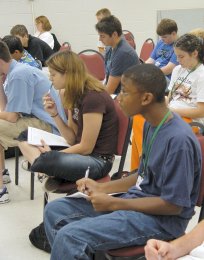Building Communities of Learning

The Gap
By Andy Carvin -- 3/1/2006 -- School Library Journal.com
Once a hot topic, the digital divide seems all but forgotten, while the poor, mainly black and Hispanic, are still being left behind
"Despite all the incredible advances in streaming video and Web-based multimedia, the Internet remains a text-dominant medium. If you lack a strong foundation in literacy skills, all the Internet access in the world isn’t going to do you a lot of good.
Unfortunately, the digital divide is rarely addressed as a major policy issue in America. But as the U.S. struggles to improve its schools, while dragging its heels at improving our national broadband infrastructure, countries like India and China are churning out highly skilled young people for their workforces. At the same time, Nordic countries and Korea deploy ubiquitous Internet access. Other nations are creating government ministries to spur technological and educational innovation, while American digital divide policies have fallen off the docket. America is losing its competitiveness because we’re not making the necessary investments in education and infrastructure.
Fortunately, there is still positive work being done. The federal e-rate program continues to enable low-income schools and libraries to connect to the Internet, while nonprofit and private sector entities invest in local and national efforts dedicated to bridging the gap (see “Bridging the Divide,” above). Meanwhile, copyright initiatives like Creative Commons ease the way for people to publish their own content for broad public use. And open courseware initiatives from universities, such as MIT, are making some of the most coveted curriculum freely available, whether you can afford to attend the brick-and-mortar institutions or not.
The challenge remains, however, to get the digital divide back on the national agenda. The disparity in technology access must be viewed as a national threat—to our economic competitiveness, our civil rights, and our national creed of equal opportunity. While it may be true that seven out of 10 Americans are online, we shouldn’t pat ourselves on the back just yet. Not as long as disenfranchised, underserved Americans remain on the wrong side of the divide." (Carvin, 2006).



0 Comments:
Post a Comment
<< Home